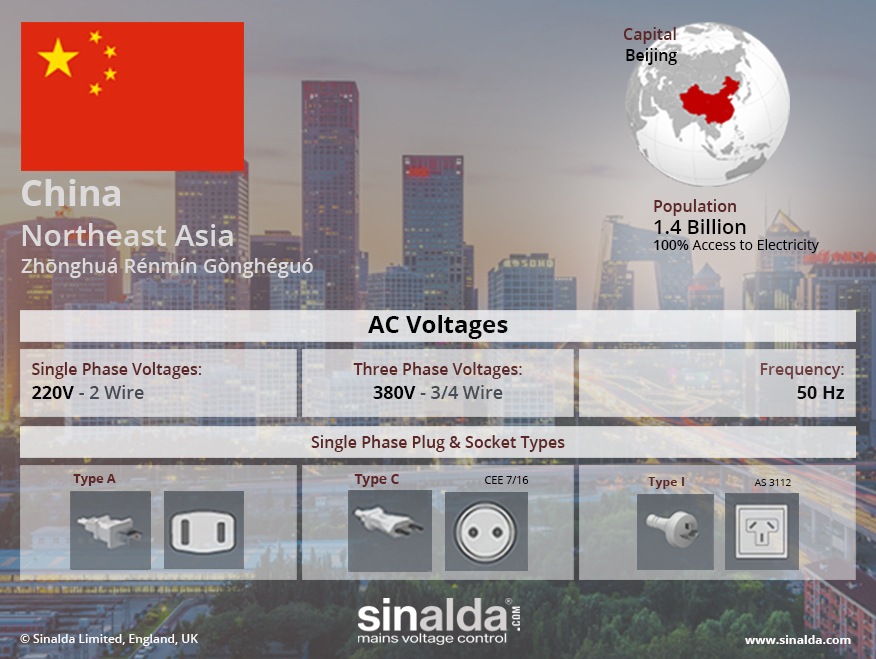Last Updated: 01 November 2021

Copyright 2021 Sinalda. Permission to use this image is granted subject to appropriate credit being given to www.sinalda.com as the source.
Power Quality in China (People’s Republic)
Despite a massive investment over the last two decades in new generation capacity, the continuing lack of a unified national grid system impedes the efficiency of power generation nationwide and means there is an increasing risk of localised shortages – resulting in unplanned outages and brownouts. Eastern and southern areas are particularly prone to shortages in late spring/early summer as temperatures and air conditioning demand rise, while reservoir levels and hydro output fall until the arrival of the summer rains in July and August. Northern areas experience shortages in winter due to increased heating demand and problems with coal deliveries.
Power Sector in China (People’s Republic)
In 1949, on the formation of the Peoples Republic of China (PRC), the country had just 1.85 GW of installed electricity generating capacity to support a population of 540 million. By 1982 capacity had grown to 50 GW and the population had risen to over 1 billion of which 80% lived in rural areas with limited or no access to electricity. According to figures available from the World Bank by 1990 more than 94 per cent of the population had access to electricity and capacity had grown to 138 GW. The subsequent 20 years saw massive economic growth and fuelled a huge and ever increasing appetite for power. So much so that by 2011, with a population standing at 1.4 billion, available generation capacity passed the 1,000 GW mark and the World Bank reported near-universal electricity access at 99.7%. Since then China Voltage capacity has continued to grow and currently is estimated to stand at 1,505 GW making the country the largest producer and consumer of electricity in the world.
To meet demand arising from huge economic growth it has necessitated a colossal investment in generation capacity and transmission infrastructure on a scale and speed never seen before in world history. In 2007 it was widely reported that China was building about two new power stations every week. However recently published data (July 2015) by the National Energy Administration (NEA) would seem to indicate that demand is beginning to stabilise, reinforcing the generally accepted view that the country is entering a period of slower economic development.
With abundant natural resources, China has the world’s third-largest coal reserves and massive hydroelectric resources. The country currently generates a staggering 75% of its electricity from coal-fired power stations (generating substantial toxic air pollution!) and 17% from hydro-electric stations, including, since 2012, the Three Gorges Dam – the largest hydro-electric power station in the world.
BBC News: Pollution Highlights China’s Energy Problem – Jan 2013
Unfortunately there is a geographical mismatch between the location of the coal fields in the north-east (Heilongjiang, Jilin, and Liaoning) and north (Shanxi, Shaanxi, and Henan), hydropower in the south-west (Sichuan, Yunnan, and Tibet), and the fast-growing industrial load centres of the east (Shanghai-Zhejiang) and south (Guangdong, Fujian). The inability to mine enough coal and the transportation infrastructure’s inability to deliver the coal to the power-stations in timely manner can result in regional power shortages. The situation is further exasperated by the lack of long-distance power transmission capacity meaning that power cannot be routed in from other regions where there is surplus capacity.
Since 2005, with passing of the Renewable Energy Law, the government, through actively encouraged investment in clean energy resources, has sort to reduce the countries dependence on coal generation and as a result attempt to limit air pollution. While today renewable resources still only generate about 8% of the nation’s capacity, China is now the world’s leading renewable energy producer having invested in the sector more than $400bn in last ten years. Moving forward the Chinese government has committed itself to producing 16% of its primary energy from renewable sources by 2020.
BBC World News: World’s Biggest Push for Wind Power in China – Jan 2014
In the generation sector, more than 90 percent of total installed generating capacities is state-owned. For the last 20 years, China’s electricity sector has had one foot in its planned economy past, and one foot in transition. Moving out of the planned economy and setting up an independent regulatory system is seen by many commentators as a necessity for China’s electricity sector, being viewed as an essential requirement to ensure the long-term success of China’s energy and climate policies.
Today, China’s power transmission system still remains relatively under-developed. There is no national grid. Instead there are six regional grids – five managed by the giant State Grid Corporation (north, north-east, east, central and north-west) and an independent grid (south) managed by the South China State Grid Corp (covering the light manufacturing hub around Guangzhou-Shenzhen and the inland areas of Guangdong, Guangxi and Guizhou). Even within these grids transmission capacity is limited. Many towns and enterprises rely on local off-grid generating plants. More importantly, inter-connections between the grids are weak and long distance transmission capacity is limited.
In recognition of this problem, China is currently investing heavily in many substantial long distance transmission projects with the objective of creating a truly national ‘smart’ grid by 2020.
Until such time as the country introduces an independent regulatory system and a national transmission grid is in place, China’s will continue to face a challenge in driving economic growth and at the same time delivering dependable power for all. This challenge will be made even more difficult by the stated desire to continue to provide low energy pricing, whilst simultaneously attempting to control demand by curtailing wasteful energy consumption.
Share your Views and Experiences
Every reasonable effort is made to ensure that the information provided above is accurate. No guarantees for the accuracy of the information is made.
So we are able to keep the content updated, and actual on the ground experiences can be shared with others, please feel free to contact us.







